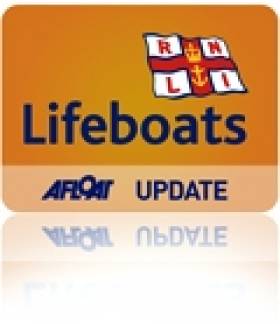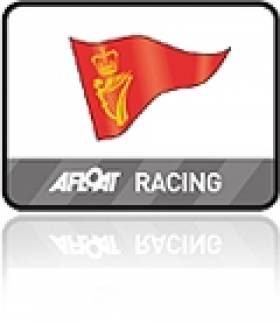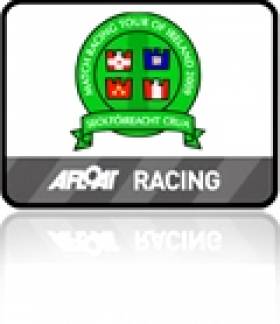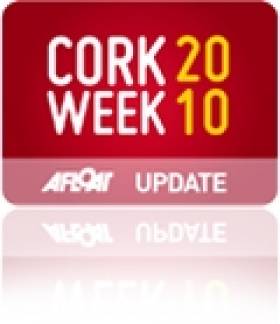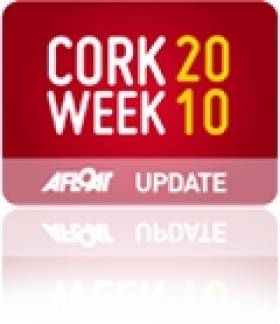Displaying items by tag: Crosshaven
Five Incidents in Four Days for Cork Harbour Lifeboat
Crosshaven Volunteer RNLI Lifeboat has had a very busy few days as they were tasked to five incidents in four days.
On Thursday evening at 17.59, the Lifeboat was tasked to the upper reaches of Cork Harbour near the city to check out an unidentifiable object in the water. On arrival, the object was found to be a large bag containing foam. Friday evening, saw the Lifeboat heading up the Owenabue River to rescue two punts which had been floated off on the very high Spring tides and were perceived a danger to shipping.
Saturday evening at 20.34, the Lifeboat was again tasked to the North side of Great Island where a 55' Motor Launch with 3 persons on board had mechanical difficulties and drifting in high winds of force 7. On arrival at scene, the crew decided that because of the size and weight of the vessel and the high winds it was safer to anchor the vessel and take off the crew. They were safely landed at East Ferry Pier. As the Lifeboat was returning to Crosshaven, The Coastguard at Valentia again tasked the Lifeboat to search the area between Cobh and Monkstown for an overdue Rigid Inflatable Boat (RIB). After searching for a period, and with nothing found, the Coastguard stood down the volunteer Lifeboat crew to return to station.
Sunday afternoon, and the pagers were again activated at 16.33 to go to the aid of a small boat with engine problems at East Ferry. On arrival in the area, it was noticed that the casualty boat had managed to restart and head into East Ferry Marina.
Related Safety posts
RNLI Lifeboats in Ireland
Safety News
Rescue News from RNLI Lifeboats in Ireland
Coast Guard News from Ireland
Water Safety News from Ireland
Marine Casualty Investigation Board News
Marine Warnings
Cork Harbour Fort Attracts Thousands of Visitors
Thousands of people from all over Ireland visited Fort Camden, Crosshaven during September when the fort, officially named as Fort Meagher, was open to the public for the first time.
The partnership project, which is being spearheaded by Crosshaven Tourism on behalf of the local community association, is being undertaken by Fas workers with funding from Cork County Council and the active support of Rescue Camden, local businesses and other volunteers the local community
At a reception to mark the restoration of two of its barrack rooms, County Manager Martin Riordan congratulated everyone involved. 'This is all about action by a small group with lots of energy and commitment to their own locality. There's lot of talk about what could and should be done but right now we need more bodies like Crosshaven Community Association and Tourism'.

Mr Riordan paid tribute to Fas and praised the staff in the county council who put so much work into the project over many years, including former chief planning officer Brendan Kelleher. He concluded by saying that there had to date, been a tremendous return for a relatively small investment.
Congratulations were also extended by Cllr John A Collins who said it was a landmark day and the start of a bright new beginning for Fort Camden. The fact that on the day he visited during September, he heard so many non-Irish accents confirmed its exciting potential as a military heritage, tourism and arts attraction.
Paul Brierley, chairman of Crosshaven Tourism said the opening of the first two rooms to be restored was a day of celebration. He spoke of the tremendous voluntary ethos and goodwill and believed the project would be 'a template for the county'
He thanked the county manager 'for allowing us a sense of community ownership, his belief in our ability to deliver, his support thus far' and applauded him for 'a shared vision of realizing the tourism potential of Cork Harbour of which there can be no doubt Fort Camden and indeed Crosshaven will have a huge role to play'.
'We have opened the gates to what we feel will be the 'jewel in the crown' of Cork Harbour and Crosshaven, one of the finest remaining classic artillery forts in the world named after one of the most famous men in Ireland, Thomas Francis Meagher', said Paul who urged people to continue supporting the project and visit the website www.rescuecamdenm
Further works are ongoing and it is hoped to again re-open to the public Fort Camden on a temporary basis in March.

Pictured at the reception (from left) Cllr Paula Desmond, County Manager Martin Riordan, Cllr Deirdre Forde, Simon Coveney TD, Deputy Mayor of County Cork Cllr John A Collins and Cllr Seamus McGrath.
1720s Ready for Cork Harbour October Contest
Ten 1720s will contest Sunday's first race of Royal Cork's October league in force. The 2010 league marks the return of these sports boat to Cork Harbour but it comes at the expense of the club's three Commodore's cup boats originally planning to take part.
At least two 1720s are entered by the O'Leary family which almost certainly means the Ker 39 Antix will stay on its berth. Peter O'Flynn from Baltimore is sailing and other 1720 entries have been received from Tom Durcan and Denis Murphy.
Following the successful Commodore's Cup campaign Marinerscove is now in the UK and Andrew Creighton has indicated the small boat Roxy will not be sailing.
There have been a few tweaks to the format of the league and this year there will be two courses both starting with committee boats.
Competitors from other south coast ports such as Waterford Harbour SC arrived in Crosshaven this week.
Course Zero, One and Two and 1720 designated as Red Fleet while classes three, four, Whitesail One and White sail Two will be designated Green Fleet and the classes will alternate between the courses each weekend.
Prizes will be awarded for first, second and third place in each class and a daily prize giving will take place no later then 17.30 hrs in the RCYC Club House. The final prize giving will take place at the prize giving gala dinner on Saturday, October 30th.
Taking Care of Sails this Winter
Mildew
Caused by storing sails wet and dirty, or salty. Remove by soaking for 2 hours in a cold solution of 1 part of bleach (Domestos etc) added to 10 parts of water. Rinse afterwards and repeat as required.
Bloodstains
Caused by overworking crews! Soak in a solution of half cup of ammonia to half gallon of water. Rinse thoroughly
Oil and Grease stains
Small areas can be cleaned with a dry cleaning fluid such as TRI or PERCHLORETHYLENE. For larger areas use a cleaner such as Polyclens. Brush it well into the fabric, leave it for 15 minutes and wash off in lukewarm water. Please note that some grease stains will contain metal or rust particles which are hard to remove. Try 1 oz. oxalic acid in a pint of hot water as a rust remover but do wash the sail and your hands thoroughly afterwards.
Paint and Varnish
Don't use paint stripper – it removes sail and all! Try alcohol (but not the best Jameson's) or Meths. If that isn't potent enough use TRI or PERCHLORETHYLENE, followed by a 50/50 mixture of acetone and amyl acetate. Wash with warm water and detergent to avoid the very un-nautical smells!
Having got the worst stains off your sails, you now come to the washing – and maybe at this stage the thought of ringing us to collect and wash is quite attractive!
Small sails can be washed in the bath and large ones on a clean wash down area, using a scrubbing brush and a hose. Don't use water hotter that comfortable hand temperature. Any brand of liquid detergent can be used.
Very dirty areas can be treated with neat detergent and left overnight before scrubbing off.
Don't leave the sail to soak or dry on corrosive or hot pipes – you might end up with dirtier sails or have odd shapes heat-shrunk into them.
Speaking of odd shapes, this is the perfect time to get your sails re-cut to bring back their original shape, speed and performance.
When you get your sails back from us, store them in a dry place and when the 2011 season comes they will be in the best possible condition to serve you once again.
Sailmakers have various arrangements for the pick, up and delivery of sails. If after reading this advice and you're in need of some professional help, why not consult our advertisers in this feature?
Commodores' Cup Arrives in Ireland
The Rolex Commodores' Cup arrived back in Cork last night and winning team Ireland received a heroes welcome from the Royal Cork Yacht Club writes Claire Bateman.
In his welcome Admiral Paddy McGlade mentioned there were ten trophies for the event, eight of which were won by Team Ireland. One was for best British boat that obviously Ireland couldn't win, and the other was for best female crew category which they certainly couldn't win! When Team Leader Anthony O'Leary arrived he received a standing ovation and was joined by Andrew Creighton and his family.
Unfortunately marinerscove.ie skipper David Dwyer was still on his way home and could not be present but nonetheless marinerscove.ie was very much in the minds of all present.
In the Team Leader's speech Anthony made special mention of and paid tribute to Rob Davies of Roxy 6 and the hugely important part Roxy had played in the successful outcome.
He said Antix and marinerscove.ie had been around for some time but Roxy was a new build recently launched. He again expressed his gratitude for the unstinting and unswerving support so generously provided by Rob Davies any time it was requested for Roxy's campaign.
ICRA Commodore Barry Rose also spoke and gave a graphic description of the final race of the series and how well the Irish team coped with the conditions when all around them other boats were having major difficulties.
The formalities over, the Admiral rang the bell and the team members and their supporters enjoyed refreshments as they relived the seven days of the Rolex Commodores' Cup.
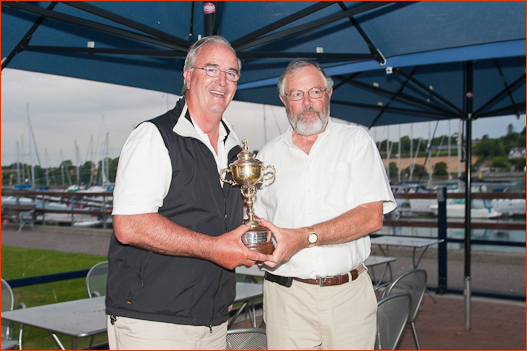
Job well done. Team Ireland Captain Anthony O'Leary is welcomed home by Royal Cork Admiral Paddy McGlade. Photo: Bob Bateman
An tSciocháin, a 1956 Bounty ll, crewed by five volunteers from the Crosshaven Lifeboat and skippered by Pat Fagan was the sole Irish entry in La Coupe des TROIS Phares that departed Crosshaven for France at the weekend.
An tSciocháin is skipperd by Pat Fagan with crew members Brendan Fagan, Pat Harris, Alan Barton and Gus O’Donovan
The competitors crossed the start line at the mouth of the harbour between the committee boat and the E4 mark under National Race Officer, Richard Leonard assisted by RCYC Admiral Paddy McGlade writes Claire Bateman.
The event is a long-range cruising-race the classic yachts from
With a northerly wind and an ebbing tide (PHOTOS BELOW) the sailors were wise in being a little bit shy of the line but with spinnakers hoisted off they went and made a pretty sight as they headed out into the open sea watched by spectator boats including the Crosshaven Inshore Lifeboat. returning from exercise. The fleet was accompanied by their mother ship Notre Dame des Slots and other vessels.
There was a very nice gesture from the competitors as each yacht saluted and thanked the Race Officer as they passed the committee boat.
No doubt many of the boats had stories attaching to them but none more so than the yacht Pen Duick ll formerly owned by the late Éric Tabarly and now in the ownership of the École Nationale de Voile. Monsieur Tabarly, a former French Naval Officer was often known as the father of French sailing.
It has been a very enjoyable week for both the Competitors and the Royal Cork Yacht Club concluding with a dinner in their honour last evening (Fri) complete with traditional Irish entertainment consisting of music and dancing with the French visitors joining in with gusto. The partying went on until the early hours of the morning. Many friends were made and there is expectation they will return again to the Royal Cork Yacht Club in 2012.

Pat Fagan's 'An tSiochain' departs Cork Harbour for France. Photos: Bob Bateman
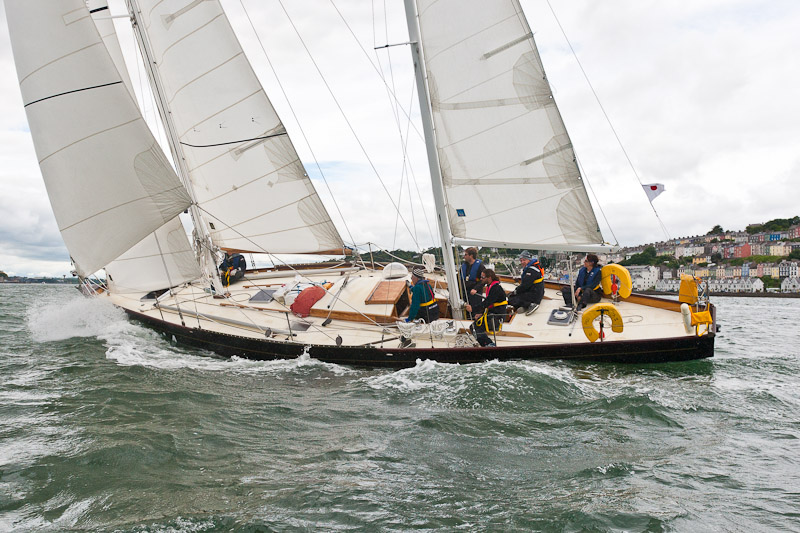

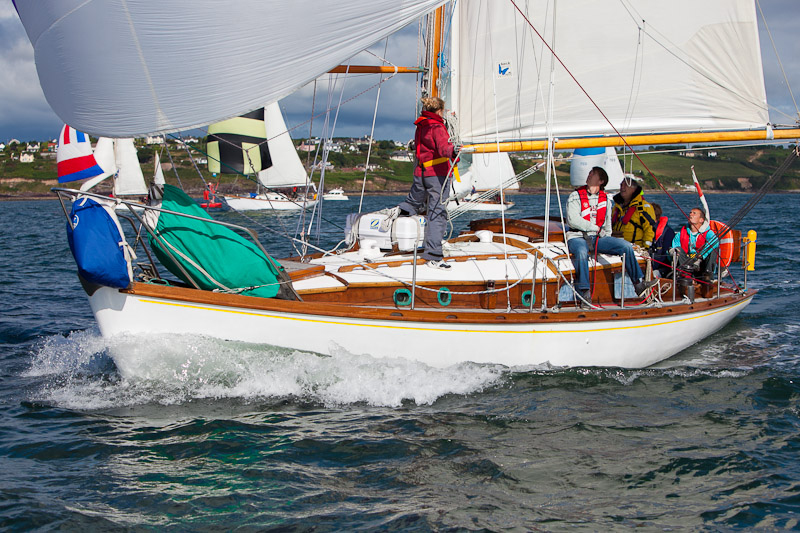
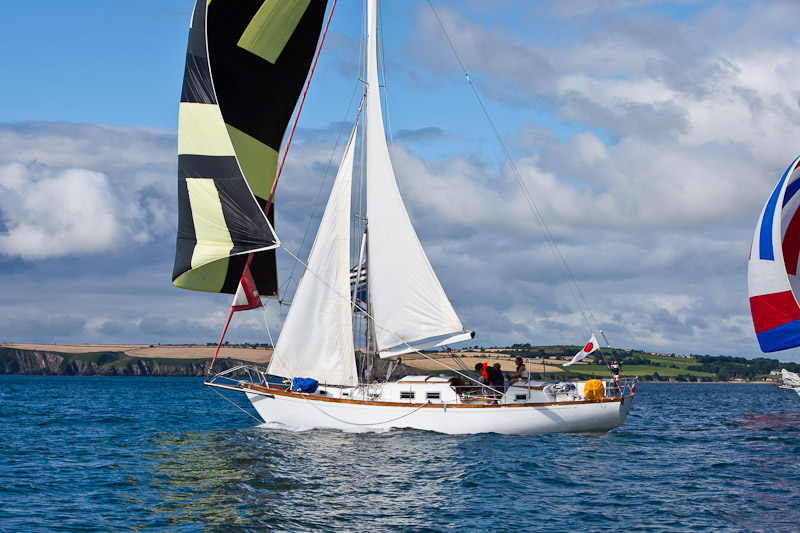



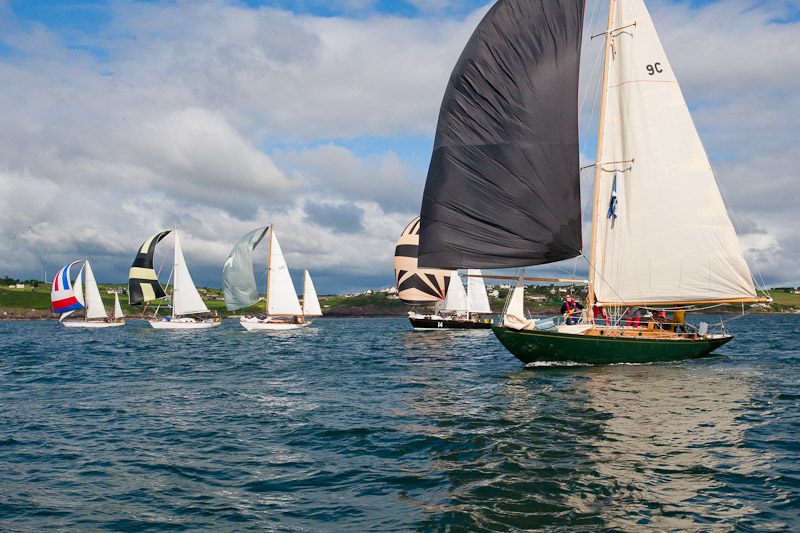
More Photos on the Gallery HERE
Cork Match Racing Open Cancelled Due to Lack of Race Officers
Match Racing Ireland (MRI) has cancelled the Cork Match Racing Open due to be held in ten days time.
The Royal Cork Yacht Club (RCYC) was running the Open, an event that forms the final leg of the Irish Match Racing Tour before the National Championship to be held in Kinsale at the end of October.
However in a statement issued this morning MRI says that "due to the unavailability of a suitable race management team Royal Cork YC and Match Racing Ireland have regrettably come to a decision to cancel the Open".
The MRI statement goes on to say:
"This is obviously very disappointing for every one concerned but we felt that invitations should not be sent out, committing teams to accommodation and transport arrangements, unless we were confident that we would be able to arrange an event of the quality we all expect.
We apologise to the teams who where looking forward to attending.
Looking at the reasons for the cancellation the main issues seem to be a question of scheduling. Post Cork Week burn out, other championship commitments and plain simple family holidays have spoken for a number of the race management teams that would normally be supportive of match racing. On the other hand the extra resources we need and challenges of running 30-40 races a day mean that it unfair to throw
some one in at the deep end at short notice"
There were also issues with the Dublin Match Racing Open in May because of the availability of crews and MRI says it won't schedule events around this time again because of exam timetables.
The statement continues: "Any sailing series in Ireland with out the involvement of Cork, well it's just not the real deal. There are plenty of Cork sailors involved with match racing, our main pool of Irish umpires are based in the county and RCYC and Kinsale have been at the forefront in terms of pushing match racing forward in this country."
It is understood Royal Cork has requested that MRI set-up an open meeting later in the year to get every one in the county with an interest in match racing together and look at how to take it forward.
Majority of Lifejackets Fail Lifeboat Test
Over 90% of lifejackets tested at Ireland's two biggest sailing centres failed simple checks carried out by the Royal National Lifeboat Institute (RNLI) last week writes Irish Times Sailing Columnist David O'Brien.
From 91 jackets tested in Cork and Dublin, 83 failed a free inspection.
The annual Lifejacket check service carried out by the institute was only taken up by 40 sailors from an estimated 1,000 competing crews at Cork week. 35 failed the test.
In Dun Laoghaire, last Saturday the RNLI offered the service again prior to Dublin Bay racing, where the total fleet is over 300 boats, the country's biggest sailing centre. 51 from a possible 2500 lifejackets were checked. Only three were deemed ok.
There were several different reasons for the failures including rusty or out of date inflation capsules but the bulk were rejected because jackets were not fitted with crotch straps. "It is the RNLI opinion these lifejackets may not work to their full potential because they may not keep the wearer's airway above water", says the RNLI's Kevin Rahill.
It's an important point so it is a wonder how lifejackets can be sold without them. What is not explained though is why so few sailors took up the free check or why nearly half the lifejackets presented had out of date capsules?
There is little doubt there has been an increased use of lifejackets in recent years but as last weeks survey shows it's equally important to know the lifejacket you are wearing actually works if you end up in the water.
RNLI Lifejacket Checks
Crosshaven:
LJs Checked 40
Ok 5
No Crotch Strap 18
OOD Capsule 22
OOD Hammar 1
Mk 3 Head 1
Rusty Cyl 2
Slack or Cyl out 4
Fired 3
Condemned (evidence of severe damage to fabric, mechanism etc) 1
Dun Laoghaire:
LJs Checked 51
Ok 3
No Crotch Strap 30
OOD Capsule 21
OOD Hammar 9
Mk 3 Head 1
Rusty Cyl 4
Slack or Cyl out 2
Fired 1
Condemned (evidence of severe damage to fabric, mechanism etc) 5
Since this article first appeared in the Irish Times on Friday, July 27 plans are afoot to test Lifejackets again in Dun Laoghaire in August or September.
We want your view on our forum thread HERE!
Related Safety posts
RNLI Lifeboats in Ireland
Safety News
Rescue News from RNLI Lifeboats in Ireland
Coast Guard News from Ireland
Water Safety News from Ireland
Marine Casualty Investigation Board News
Marine Warnings
Last Day Video from Cork Week 2010
Day 4 Cork Week Vid is a Cracker! Watch HERE!
Looking more like a leg from the Volvo Ocean Race, Cork Week yesterday enjoyed an epic day four and this Digby Fox video (below) proves it! A 20 knot ripper!


























